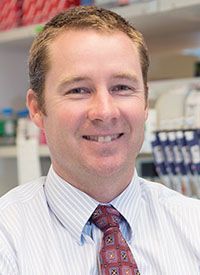CAR T-Cell Therapy Active in High-Risk, Refractory CLL
Patients with refractory chronic lymphocytic leukemia achieved a high-response rate with CD19-targeted CAR T-cell therapy JCAR014.
Cameron J. Turtle, PhD, Clinical Research Division, Fred Hutchinson Cancer Research Center,

Cameron J. Turtle, PhD
Patients with refractory chronic lymphocytic leukemia (CLL) achieved a high-response rate with CD19-targeted CAR T-cell therapy, results of a small, single-arm study showed.
Overall, 15 of 22 patients achieved objective responses, including 4 complete responses. Additionally, 15 of 17 patients with bone marrow involvement had no evidence of disease in marrow after CAR T-cell therapy.
The subgroup of patients who met International Working Group on CLL criteria for response and had no malignant IgH sequences in marrow had a progression-free survival (PFS) and overall survival (OS) of 100% after a median follow-up of 6.6 months, as reported at the 2017 Society of Hematologic Oncology meeting.
“In high-risk CLL patients, CD19 CAR T cells of defined composition can be administered with an acceptable early toxicity profile,” said Cameron Turtle, MBBS, PhD, an attending physician at the Fred Hutchinson Bone Marrow Transplant Program and Immunotherapy Service in Seattle. “Deep marrow clearance by IgH sequencing after CAR T-cell therapy provides early signs of durable responses, with 100% progression-free and overall survival.”
The findings came from a phase I/II study of JCAR014 CAR T-cell therapy in adults with relapsed/refractory B-cell malignancies. The total study population comprised 48 patients with acute lymphoblastic leukemia and 64 with non-Hodgkin’s lymphoma, as well as 24 patients with ibrutinib (Imbruvica)-refractory CLL, who were the focus of Dr. Turtle’s presentation.
The 24 patients had a median age of 61, and they had received a median of 5 prior lines of therapy for CLL. Four patients had undergone stem-cell transplant. There were 19 patients who were ibrutinib-refractory and 6 venetoclax (Venclexta)-refractory. All but 1 of the patients had high-risk cytogenetics, and all but 1 had extramedullary disease.
Lymphodepleting chemotherapy preceded infusion of CAR T cells in all cases. In 21 of 24 cases, patients received cyclophosphamide-fludarabine chemotherapy. The dosage of CAR T-cell infusions ranged from 2 x 105 to 2 x 107 cells/kg bodyweight.
Dr. Turtle said 18 patients received a single cycle of therapy, and 6 received a second cycle for residual disease or relapse. All but 6 patients were treated on an outpatient basis.
Restaging by computed tomography at 4 weeks showed that 1 of 3 patients who received noncyclophosphamide/fludarabine lymphodepletion achieved an objective response, as did 14 of 19 patients who received cyclophosphamide/fludarabine, including all 4 complete responses. Of 16 ibrutinib-refractory patients evaluable for responses, 11 achieved objective responses, including the 4 patients who had complete responses.
Analysis of bone marrow by flow cytometry showed 1 of the 3 patients who received nonstandard lymphodepletion had no evidence of disease in marrow, as did 15 of 17 patients who received cyclophosphamide/fludarabine lymphodepletion and 11 of the 16 patients with ibrutinib-refractory disease.
Among patients who had PET-avid disease at baseline, 8 of 12 had objective responses, which were complete responses in 7 of 8 cases. Eight of 11 patients with ibrutinib-refractory disease and PET avidity at baseline also responded to treatment, including 7 complete responses.
Dr. Turtle said patients who had lymph node responses at 4 weeks had longer PFS and OS, a median of 9.7 months for patients who had complete responses and PFS not yet reached after partial response versus 1 month for patients who did not achieve objective responses. Median OS had yet to be reached for any patient who attained an objective response (partial or complete), as compared with 4.1 months for patients who did not achieve an objective response.
Fourteen of 17 patients who had bone marrow clearance by flow cytometry subsequently underwent IgH deep sequencing of bone marrow, which revealed absence of the index clone in 7 of 14 cases. Patients who had negative bone marrow by IgH sequencing had yet to reach median PFS as compared with 8.5 months for the IgH sequencing-positive patients (P= .0253). All 14 patients with negative flow cytometry results had reached median survival, regardless of IgH sequencing status.
Higher attained counts of CD4-positive and CD8-positive cells were associated with improved PFS (HR, 0.56; P= .025).
In general, cytokine release syndrome (CRS) occurred early and was not severe. Four patients had grade 0 CRS, 8 had grade 1, and 10 had grade 2. One patient each had grade 4 and grade 5 CRS. The same was true of neurotoxicity, which was grade 0 in 10 patients, grade 2 in 2 patients, grade 3 in 5 patients, and grade 5 in 1 patient.